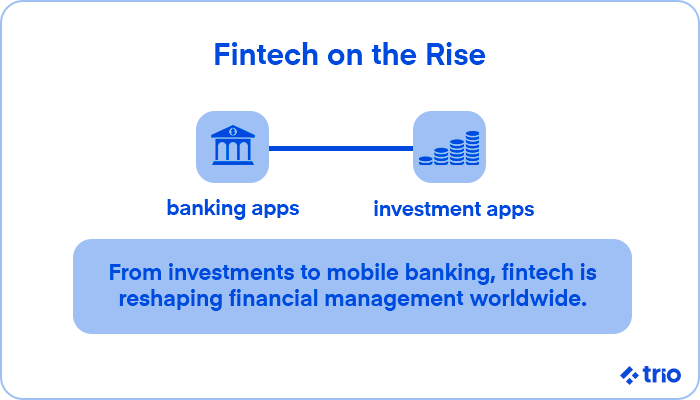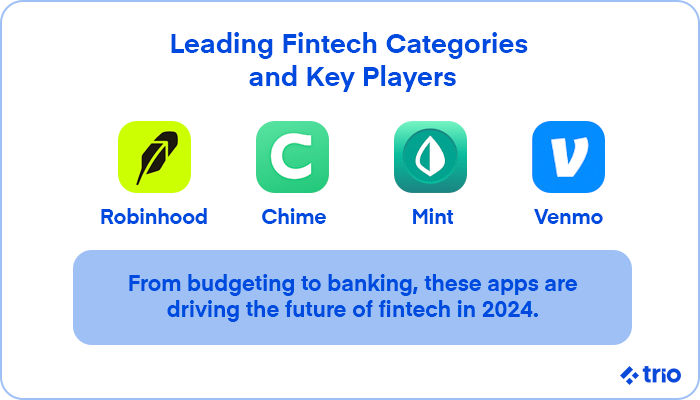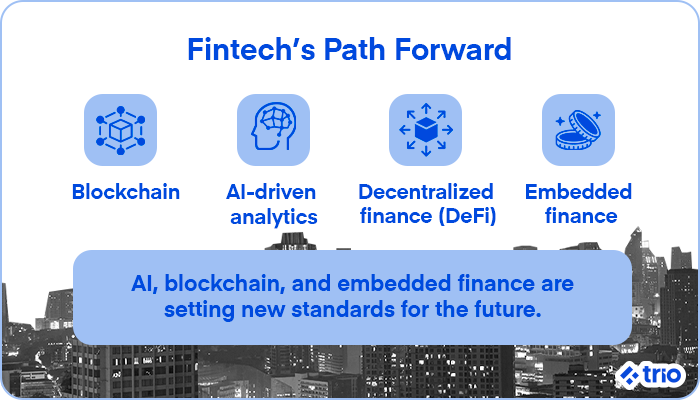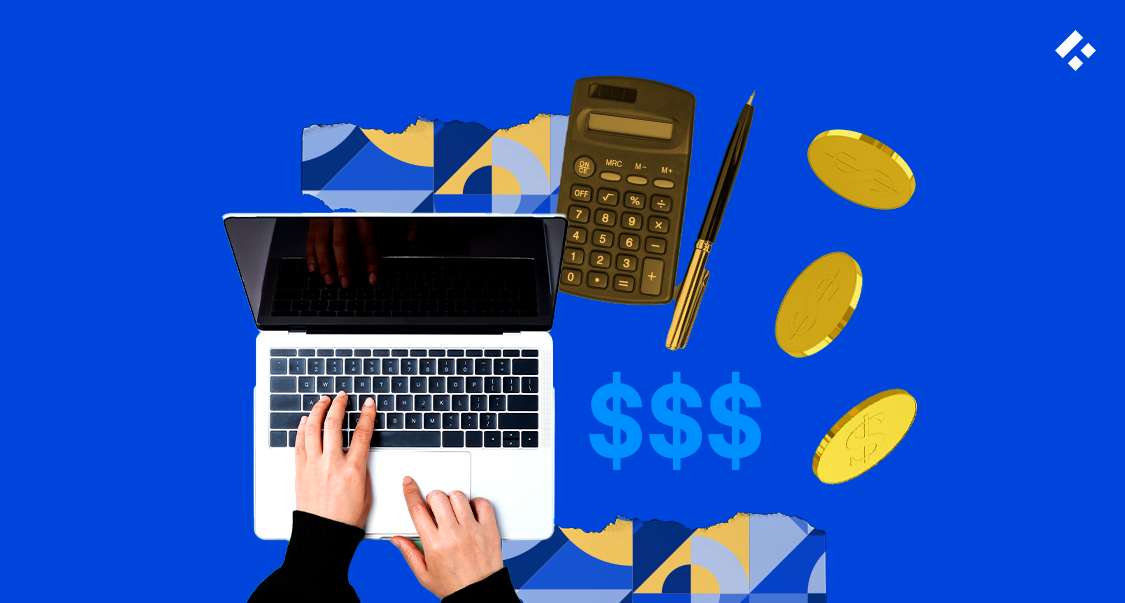The fintech industry is advancing rapidly, transforming the way that everyone in the world manages, invests, and transfers money. We’ve seen everything from mobile banking and crypto wallets to simple budgeting tools integrating more features. Competition is steep, but you can learn from some of the most successful apps to adapt.
There are several standout fintech apps that are making waves in the financial world from which you can take inspiration for your own creation.
The most innovative fintech apps include everything from commission-free stock trading to mobile-only banking solutions; these apps provide smart, user-friendly tools to help people manage their financial lives more efficiently.
In our experience, the best apps combine simplicity with powerful features, making them accessible to both casual users and finance-savvy individuals.
Most of the biggest names in fintech right now have also perfected their scalable architecture and user experience, while putting in the effort to ensure their apps are secure and compliant. All of these factors build brand trust, which is critical in any part of the finance industry.
If you are interested in creating a robust fintech app of your own, our outsourcing and staff augmentation models might be the right, cost-effective development option for you.
Our focus on developer well-being means we’ve been able to retain highly skilled developers with experience in niche markets like mobile fintech app development. Reach out to us to learn more about our fintech services.
But first, let’s look at the top 12 fintech apps you should check out so that you can help your users take control of their finances and make informed decisions.

What Are the Best Fintech Apps of 2025?
In our experience, a great fintech app doesn’t just offer financial services – it also provides an intuitive user experience, robust security, and a variety of features that meet diverse financial needs.
With the amount of competition in the industry, and overall shifts in user expectations as they become used to these features, these qualities have shifted from ‘nice-to-haves’ to the most basic requirements for getting users and retaining them.

User-friendliness is crucial; even complex financial tasks like investing or budgeting should feel simple. Apps like Robinhood and Mint are great for this, providing tools that are easy to navigate, even for first-time users.
Some of our experienced UX/UI developers have provided insights on how to understand the challenges your users might experience and how they may use the app will affect your design choices. They can help you optimize your interface as well as processes like onboarding, and make sure your app is aligned with user goals to make their experience effortless.
Security is another key factor. Given that these apps handle sensitive personal and financial information, they need to employ top-tier security features such as encryption, two-factor authentication, and biometric verification.
Coinbase, for example, takes this seriously, with 98% of users’ assets stored offline and secure logins that provide peace of mind. PayPal and SoFi also implement these layered security protocols and fraud detection to reinforce their trustworthy brands.
Versatility is another feature that you should be considering when starting software development.
Platforms like SoFi and Revolut offer a wide range of services, from savings and the ability to invest in stocks to lending and payment transfers, all within a single app.
In our view, fintech apps that allow users to manage multiple financial aspects in one place, becoming a comprehensive personal finance management app, are ahead of the curve and likely to outcompete apps by other development companies, especially in younger markets like Gen Z and Millennials, who expect this convenience.
The top fintech apps in 2025 stand out for their ability to solve everyday financial problems in ways that are accessible and cost-effective.
Among the Top 12 Fintech Apps, several have gained immense popularity due to their standout features and user-centric designs:
1. Robinhood
The Robinhood app leads the investing space. It has dominated the markets with its commission-free trading platform for stocks, ETFs, and cryptocurrencies.
The app also offers simplicity and accessibility that make it especially popular among younger, tech-savvy investors looking to enter the market with minimal barriers.
Some of the biggest lessons you can take from its success include the value placed on clean UI, gamified experience, and instant account setup. If you’re building an investment app, consider these lessons carefully.
2. Chime
As one of the top fintech mobile apps, Chime offers fee-free banking services that users love.
Chime is a fintech app that offers features like early access to paychecks and automatic savings tools.
This has made Chime a favorite for those seeking to streamline their everyday banking without dealing with hidden fees or traditional banking hassles.
For fintech startups, Chime and other neobanks can provide valuable lessons on how to build trust with the underbanked or people who cannot afford traditional banking models.
3. MoneyLion
Also boasting all-in-one financial services, MoneyLion is a go-to app for people who need banking, lending, and financial advice in one place.
This successful fintech application also has a subscription model, which adds value for users who want personalized financial tools and access to premium services. It’s a great example of layered monetization and how you can become profitable while avoiding transaction fees.
4. Nubank
Particularly popular in Latin America, Nubank has quickly risen as a top choice for users seeking no-fee banking and easy money transfers.
Its sleek interface and user-friendly rewards system have helped it stand out as a leader in the region’s fintech scene and even in the global fintech market.
5. Mint
In the budgeting space, Mint continues to shine. It’s one of the best thanks to its ability to gather all your financial data in one place.
Users appreciate its real-time spending updates, personalized tips, and the ease of managing budgets across multiple accounts.
6. Coinbase
Leading the way in cryptocurrency, Coinbase is trusted by millions for its secure trading platform, setting new standards for user education and layered security.
Its user-friendly approach to buying, selling, and storing cryptocurrencies has made it a top choice, especially for those just entering the crypto space. We have personally seen how important this can be when promoting the growth of fintech solutions.
7. Revolut
Known for its global banking features, specifically its embedded finance and cross-border payment features, Revolut is among the best for users who need multi-currency accounts and seamless currency exchanges.
Its rapid growth and user-friendly tools have earned it a top spot among money transfer apps that cater to a global audience.
8. N26
This mobile-first banking app has gained a strong following for its flexibility and focus on security.
With features like instant spending notifications and its “Spaces” feature for goal-based saving, N26 is popular with users looking to organize and simplify their finances.
While it’s quite a lean banking app, it has really done well thanks to its strong, user-based design.
9. Venmo
A leader in peer-to-peer payments, Venmo’s integration with social features makes splitting bills and sharing expenses easier. It remains among the top fintech apps for casual transactions between friends and family.
One of the largest contributors to its growth has been its social use case and the natural advertising that has resulted from it.
10. PayPal
Still going strong, PayPal is a staple for secure online payments and money transfers. Its continued expansion into cryptocurrency and buy-now-pay-later services has helped it maintain its position as a leading fintech app.
It has built a global reputation for trust, and its integration with legacy platforms has only added to that perception.
11. Klarna
Gaining immense popularity for its buy-now-pay-later services, Klarna has become one of many fintech apps favored by online shoppers looking for flexible payment plans. It is easy to use, and it implements alternative credit scores to provide lending services to those who may not have access to them otherwise.
Its transparent, user-friendly model has kept up with market trends and made it particularly appealing to younger consumers.
12. SoFi
Originally focused on student loans, SoFi has grown into a comprehensive financial platform and has become one of the best fintech apps.
Its diverse suite of products – including personal loans, investments, and financial planning tools – has made it a popular choice if you are looking to grow your wealth. It can help you make the best decisions to achieve financial independence.
How to Choose the Best Fintech App for Your Needs?
When selecting a fintech app, the best approach is to consider your specific financial goals.
Are you primarily looking to budget, invest, or simplify payments?
In our experience, if you need help tracking spending and sticking to a budget, Mint or N26 are fantastic options.
Mint offers an all-encompassing view of your finances, while N26 provides a sleek interface with intuitive goal-setting features.
If your focus is on growing your wealth, Robinhood or SoFi might be better suited to your needs.
Robinhood is ideal for beginners who want to start investing without commission fees, while SoFi offers a broader suite of financial services, including loans, insurance, and wealth-building tools.
For mobile banking, Chime and Revolut are excellent options.
Chime stands out for its fee-free structure and early paycheck access, while Revolut is ideal for those who frequently deal with multiple currencies and global payments.
If you are creating your own scalable fintech mobile application, or even a web-based fintech app, consider what needs you want to cover so that you can look at the right competitors to cross-verify your fintech app ideas. You can not only consider gaps in the market but also the type of UX and features your users may expect.
For help executing your ideas, our fintech experts can join your existing team or start from scratch, creating secure, scalable solutions with the latest compliance practices, so you can rest easy knowing you are in good hands.
What Types of Fintech Apps Are Available?
There are many different types of apps available, offering specialized tools for different financial needs. Broadly speaking, fintech apps fall into a few main categories: banking, investment, budgeting, payment, and credit/lending.
Banking Apps
Banking apps, like Chime and N26, offer mobile-first banking experiences. They eliminate the need for traditional brick-and-mortar banks, providing services like direct deposit, savings tools, and fee-free accounts, all from your phone.
These apps are very popular as people start to use digital platforms for more of their day-to-day lives, and can even make use of tech like the IoT (Internet-of-Things) to reach people who may not have access to traditional banks.
Instant notifications, savings automations, and reduced fees are generally the features users expect.
Investment Apps
On the other hand, investment apps like Robinhood and Coinbase have revolutionized investing by making it easy for users to trade stocks, ETFs, and cryptocurrencies from their smartphones.
What sets these apps apart is their accessibility – Robinhood, for example, was one of the first to offer commission-free stock trading, opening up the market to a new generation of investors.
Coinbase, as we have already mentioned, gives more people accessibility to crypto markets by making the entire process simple, from onboarding to further education.
Gamification also plays a major role in these apps, greatly improving overall user experience. Our experienced developers can help you integrate features like this into your own apps by utilizing cost-effective development techniques.
Budgeting Apps
Budgeting apps are ideal if your goal is to keep your spending in check. Budgeting apps like Mint provide tools to track expenses, set goals, and receive personalized tips.
There are also budgeting apps that provide extensive features, like YNAB (You Need A Budget), such as envelope budgeting, behavior-based coaching, and more.
Payment Apps
Payment apps like Venmo and PayPal simplify peer-to-peer payments, letting users send money instantly to friends, family, or businesses.
They’re particularly popular for their convenience. Most of the time, you just link your bank account or credit card, and you can send or receive money in seconds. However, this linking means that security should be emphasized.
They work by securely linking your bank account or card to the app, allowing you to transfer funds with just a few taps or sometimes by scanning a barcode.
Apps like Venmo and PayPal make sending and receiving money as easy as sending a message. Users can instantly transfer funds to others by simply entering an email address or phone number, or by connecting directly through the app.
These payments can be drawn from the user’s linked bank account, credit card, or stored balance within the app.
Security is always a top priority, with encryption, verification steps, and fraud detection tools working behind the scenes to protect users’ financial data.
Regulatory compliance is also becoming incredibly important, with KYC (Know Your Customer, AML (Anti-Money Laundering), and data handling regulations becoming a necessity to function at all.
In our experience, these payment apps have transformed everyday transactions, making splitting bills, sharing expenses, or paying for services incredibly simple. But we have also seen how, as the field grows, so do security measures and regulations.
What Features Should You Look for in a Finance App?
In choosing the best finance app, there are several key features that, in our view, can make a big difference:
- Security
- Ease of Use
- Smart Notifications
- Alternative Monetization Models
- Integration Abilities
Security cannot be emphasized enough when it comes to financial technology, so two-factor authentication, encryption, and biometric logins (such as fingerprint or face recognition) are essential to protect your data.
The app should also be easy to use and have a clean, intuitive design that makes it easy to navigate through features. Apps like Mint are known for simplifying complex financial data into easily digestible information.
Many of the top apps, including Chime and Revolut, offer personalized alerts like instant notifications on spending, account balances, and upcoming bills, helping users stay on top of their finances.
Then, you need to consider the fees associated with transactions. Robinhood and Chime thrive by eliminating the fees traditionally associated with investing and banking.
You will also want to ensure you’re ready for integrations. This will give you flexibility long-term, allowing you to use other people’s services without needing to develop everything from scratch every time.
What Are the Leading Fintech Companies to Watch?
Several startups have grown a great deal in 2025 because of their innovative approaches and rapid growth.
MoneyLion is one such example. By combining traditional banking services with financial advice, loans, and investment options, it has created a comprehensive platform that appeals to users looking for more than just a bank account.
Its subscription model also sets it apart, offering premium banking services for a monthly fee, which includes credit score tracking, cash advances, and personalized spending insights.
Similarly, Nubank, based in Brazil, has become a powerhouse in the Latin American market. Although a lot of this growth occurred in 2023, it has continued into 2025, helping the app gain traction.
Its no-fee credit card, along with its easy money transfer system, has made it immensely popular.
What we’ve seen with Nubank is that its emphasis on simplicity and transparency is key to its success, attracting millions of users who are seeking a hassle-free banking experience.
How Do Established Fintech Companies Compare?
Established fintech companies like Robinhood, Coinbase, and PayPal will need to continue to innovate as competition heats up. So far, it seems like companies with a firmly cemented reputation won’t suffer too much.
Robinhood was one of the first apps to make commission-free trading mainstream, and it’s still a leader in this space, expanding its features to include IPO investments and cash management tools.
Meanwhile, Coinbase remains a top player in the cryptocurrency world, known for its robust security and educational tools for new investors.
While long-established, PayPal has adapted to the changing fintech landscape by offering buy-now-pay-later services and expanding its capabilities to include cryptocurrency trading.
In our view, these established companies stay ahead by continuously innovating and expanding their services to meet the evolving needs of users. This is something that you need to consider if you are creating your own fintech mobile app.
The continued support that we provide here at Trio can help you stay relevant.
How Are Fintech Apps Transforming Personal Finance Management?
There are many different ways in which fintech apps are transforming personal finance management.
What Benefits Do Fintech Apps Provide for Budgeting?
Budgeting mobile apps like Mint and N26 have completely changed the way users manage their finances.
We’ve seen how these apps make it easy to track spending in real-time, set specific savings goals, and receive personalized tips based on your financial habits.
What’s more, the app development behind these platforms ensures that they simplify budgeting by gathering data from various accounts – banking, credit cards, investments – into one central location.
Chime also stands out for its automatic savings feature, which rounds up transactions and transfers the difference into a savings account.
This small but powerful tool encourages consistent saving without the user needing to think about it, which we’ve found makes a big impact over time.
In some cases, we’ve even seen traditional banks start implementing this technique, indicating that they are possibly building trust in tech partnerships. At the very least, they are taking inspiration from independent products.
How Can Investment Apps Help You Grow Your Wealth?
Investment apps like Robinhood and SoFi have made it easier than ever for users to start investing, even with little to no experience.
In our view, what makes these apps so effective is their accessibility.
Robinhood’s commission-free trades have lowered the barrier to entry for stock and crypto investing, allowing users to grow their wealth without incurring the high costs traditionally associated with trading.
SoFi goes a step further by offering not only investment options but also loans, retirement planning, and financial advice.
What Is the Growth of the Fintech Industry?
Over the past few years, we’ve witnessed fintech evolve from offering niche services, like mobile payments or basic investing tools, to providing comprehensive financial platforms.
Fintech apps are no longer just convenient; they’re essential for millions of users who prefer managing their finances through a smartphone over traditional banking.
One of the most significant changes we’ve seen is the integration of AI into these apps.
AI-driven tools offer personalized financial advice, investment recommendations, and even automated money transfers, making it easier for users to make the best financial decisions for their individual situations.
What Trends Are Shaping the Future of Fintech?
With blockchain technology and decentralized finance (DeFi) at the forefront, many trends are shaping the future of fintech.
Coinbase is leading the charge in making cryptocurrency and blockchain more accessible, and we expect to see this technology integrated more broadly across the fintech landscape in the coming years.
Another trend that continues to gain momentum is AI-powered automation, as we have already discussed.

Apps like SoFi and Mint are using AI to provide personalized advice, which helps users make smarter financial decisions with less effort.
Additionally, embedded finance – where financial services are integrated into non-financial platforms – continues to grow, allowing users to access fintech features in apps they already use.
If you are interested in building your own mobile fintech solution or just want to dip your toes into the logistics of developing a product in financial technology services, reach out to us to set up a call.
Our thoroughly vetted, fintech specialist developers with experience in the field can help you get a better idea of what will be required going forward and can partner with you in collaborative software development.






